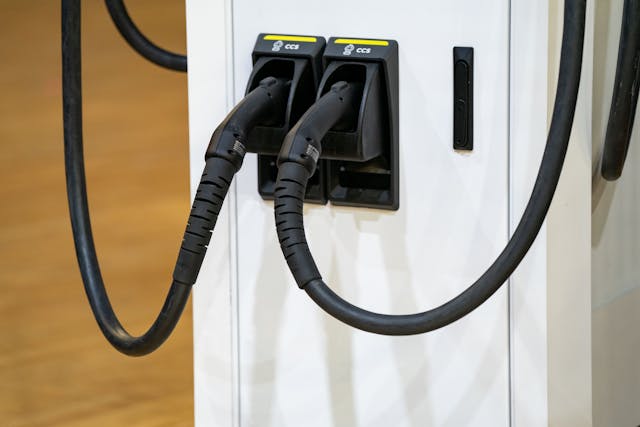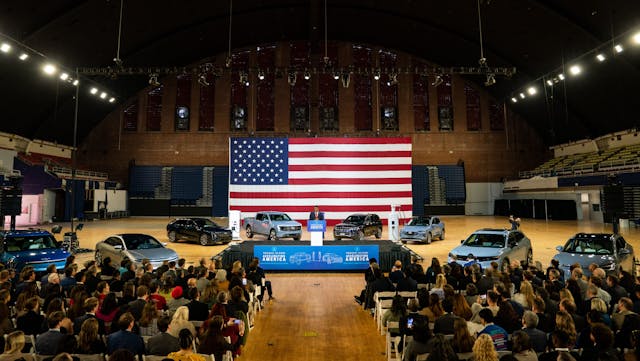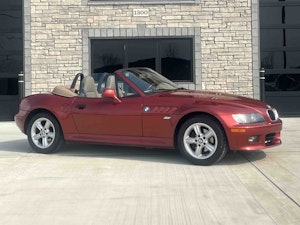Media | Articles
New EPA Ruling Offers an Olive Branch to Opposing Sides, But Neither Are Happy
The new EPA proposals decidedly aren’t a 180-degree turn from the Biden Administration’s aggressive stance from last April that called for battery-electric vehicles to make up more than half of new-vehicle sales just six years from now, and two-thirds by 2032.
But Wednesday’s revision in those standards may indeed be a 90-degree shift from what Biden and the EPA wanted.
This new proposal now estimates that battery-electric cars, light trucks, and SUVs will make up 30 to 56 percent of new vehicle sales between 2030 and 2032, but even that may be ambitious unless cooling trends in electric vehicle demand warm up quickly. Though there are 83 battery-electric vehicles on the market, just two, the Tesla Model 3 and Model Y, accounted for 57 percent of retail new EV registrations across the industry in 2023.

Critics of the new proposal, including the National Automobile Dealers Association, say that even the softened guidance is “too aggressive and far ahead of consumer demand.” In 2023, according to data released last week by the S&P Mobility research firm, battery-electric vehicles made up 8.5 percent of new, light-duty vehicle registrations in the U.S. last year.
As you’d expect from the other end of the environmental spectrum, anti-pollution advocates criticize the reduced target because of what it might do to the fight to against carbon emissions. This is despite the fact that the new EPA proposal would set tougher limits on tailpipe pollution through 2032, and enable manufacturers to use other clean-ICE technology rather than just add more battery-electric vehicles. The new regulations also give more credit to the plug-in hybrid’s ability to trim pollution.
Marketplace
Buy and sell classics with confidence
The EPA’s new rule slow-walks last April’s stricter pollution standards from 2026 to 2029 while increasing them up through 2032, ending up very nearly where last April’s initiatives would have landed, assuming this strategy works. It is lost on few that the election of Donald Trump in November might well cause a major re-write of Wednesday’s proposals.
Ralph Nader’s Public Citizen advocacy group claims that this new proposal “falls far short of what is needed to protect public health and our planet. EPA is giving automakers a pass to continue producing polluting vehicles,” Public Citizen says. “The Biden Administration had the opportunity to shift the automotive industry away from a model that’s driving record profits for automakers while literally killing us, toward one that still provides strong profits but keeps the world safer for humans.”

As it exists, the EPA’s proposal allows a manufacturer to sell ICE products, BEVs or PHEVs in whatever combination it chooses, as long as it makes its numbers. According to the EPA, a manufacturer should be able to sell between 30 and 56 percent BEVs in order to meet its pollution requirements. The new standard is based on grams-per-mile of emissions, not on the powerplant used.
Bottom line, the 1181-page document that covers the Biden Administration and the EPA’s new proposals—the “Final Rule” for vehicles “that will phase in over model years 2027 through 2032”—deftly offers something to both sides: A pause in having to worry as much about the timeline for the integration of battery-electric vehicles in a down-market EV sales atmosphere; and increasingly tough pollution standards that will, by 2055, prevent more than seven billion tons of carbon pollution from reaching the atmosphere.
So neither side is happy, but both can declare a win.
***
Check out the Hagerty Media homepage so you don’t miss a single story, or better yet, bookmark it. To get our best stories delivered right to your inbox, subscribe to our newsletters.














This is a total joke.
I’m not opposed to EV cars and them being made. I do oppose being forced into these models while tech and cost are still not ready for the main market.
The EV market was making good progress but covid hit and inflation and the cost have stopped decreasing on batteries. This has also hurt the development of new and better batteries as they are not becoming cheaper too.
Hybrids are still not the answer as the hybrids generally cost more often are under powered and still require higher emissions testing, still require ICE maintenance as well EV maintenance. It can take years to recover the added cost in driving. Most of those gains are only if you drive in town. Highway miles are not great in these models. Either way these models are not the answer either.
The American autos account for less than 2% of the global emissions and to be honest that is pretty dang impressive. There are many other areas globally that should be looked at and improved including countries that are not held to the same standard as America like China, India and most of south America.
Look we are not going to kill our grandchildren if this is delayed till it is ready before someone tries that lie.
There are better ways to walk this forward and protect what auto industry we have today. It is not just important to jobs but also to national security. I do not say this lightly as being a student of WW2 it was clear the auto industry and their suppliers may have been the major difference in the war. We could change from cars to bombers and fighters. Ford built B24 bombers in MI. GM Built Tanks and B29’s in Cleveland Goodyear built Corsair fighters here in Akron. This was just a few of the many things the industry built.
As it is now only two companies are American owned and these regulations are crippling.
People act as if the auto industry is flush with cash but they are not at the end of the day and after the share holders are taken care of. Just look at Fords stock prices and see how tough it is.
I like how GM has two lines right now where they are building ICE and EV. Let the automakers continue with this and let the consumers choose as time moves on. To force a change will be very damaging to all economically.
At times I feel the far left green agenda is not about the air bout more about destroying or industry. I don’t mean to be political but roots are where roots lay.
We do not fly people to space against their free will. It is a major risk and we only send those willing to take the chance. The same applies here.
Note resale on most hybrids are horrible as many EV models. They are like used old Cell Phones. I just saw a Hybrid that was 12 years old out of warranty and a bad battery. The battery was $4000 plus labor. The car was not worth the repair. No not all batteries are Prius small and cheap. The Hybrid trucks can get up to $8,000 for the battery and $4000 labor to change. Again the auction prices are low and no one buys when they are dumped there.
The move was not a compromise it was just to buy time for the election as this will become a topic more so sooner than later.
Here Here!
Agree 100% – especially the last line. We should be thankful we do not get all the government we pay for.
Amen to that! Where is all this clean energy coming from to change these EVs? Right now most is from oil fired generators or nuclear power plants. Not counting the year up of the environment to get at the previous metals needed to produce these batteries. And of course there’s also the question of what to do with the batteries at the end of their life cycle. I live in a place where a lot of our energy is hydro produced but I don’t believe for one moment that even that with wind power can produce the amount of energy that will be required to meet the standards that our governments are leading down. North America produces the mouse’s share, less than 5% of the pollution in the atmosphere, but they expect us to pay for the lions share!
“Right now most is from oil fired generators or nuclear power plants.” *Citation needed.
Oil-fired generation seems relatively rare. I would be curious to hear where it is common, or even “most” of production.
If only we had a database to consult!!
https://www.eia.gov/tools/faqs/faq.php?id=427&t=3
Thanks for finding and proving my point. Petroleum comprises 0.4% of energy generation. Nuclear makes up 18% which is could be argued as significant, but to say oil fired generators is “most” is absurd.
Maybe this poster is thinking oil is an acceptable word to substitute for fossil fuels?
Toyota is the leader in hybrid vehicles. An online article analyzed the payback period for the added expense of hybrid capacity. One Toyota model offered a less expensive hybrid than ICE version. Others had payback periods between three months and two years.
Prius are the car of choice for taxi and ride sharing companies. I know of several Prius owners over 300k miles on the original battery. Also, hybrids are the most reliable/trouble free. IMO, it’s the sweet spot of technology.
Let’s not even start on the climate change narrative.
The Prius is the acceptation and is a very unpowered small car most would never be happy with. Also Hybrids Excel in City driving stop and go like a Taxi. Outside that the efficiency drops fast.
The driving most Americans do are not conducive to most hybrids strong points.
Almost all of that is demonstrably untrue.
Underpowered? The new Prime makes 220 HP. You can get AWD, you can get a plug in version (the Prime) that’ll do 44 miles on a charge before the ICE motor kicks in, which, given that the average daily commute for Americans is 26 minutes, seems to be perfectly adequate. Not everyone needs to tow a horse trailer 700 miles at the drop of a hat, regardless of what most comment sections would have you believe.
Note my statement Prius is the exception. Read all the words.
I read all of your words, and nowhere did I see the word exception… 😛
Please excuse the typos….
CHARGE not “change” these EVs.
TEAR UP to the environment not “year up”.
PRECIOUS metals not”previous”.
Need a place on here to edit the comments, especially for us old folks with fat fingers and who forget to proof read before posting.
Yes.
These regulators and bureaucrats apparently think that the manufacturing process to make EVs, and the electricity to power them, comes from magic. No doubt they’re invested in forcing this stuff down our throats, and are merely padding their wallets. That motoring publications are helping force this BS and fawning over this false magic, and not telling the whole story, is depressing.
If you truly want to save the world. Organize street protests in China’s largest cities, and demand that they meet European and American industrial emission standards.
… Let me know how that works out.
The battery powered car came out before the gas powered car and batteries have come a long way since that time. To my knowledge there is not a practical battery that will last 5 years much less 10 years on this planet. Batteries still have a long way to go before they have the equivalent energy density as gasoline and not even close to diesel fuels. People who use pickups for towing RVs, boats, misc equipment and farm tractors can not depend on batteries for power, its just not practical (too short of run times with heavy loads) and someday it will be, but not anytime soon.
Most will go 10 years if not they are under warranty. You can hate EV but at least be honest.
Wait until wrecked or badly damaged (flood or tornado) EV’s start gathering space in local junkyards and our drinking water begins to have traces of lithium in it. If you didn’t think cancer and other diseases caused by chemicals contamination were not bad enough, let’s pretend electric vehicles do not pollute and are perfect solution to emissions. WRONG. The pollution is happing all around the EV. Electricity comes from somewhere. Lithium mining and processing happens somewhere. You still need foundries to make iron ore into metal. Paint, plastic, everything in a vehicle comes from somewhere. EV’s are not a solution to cleaning up the planet. Besides the US, the largest populated countries in the world could care less about any of this.
Compared to the internal combustion vehicles that end up in junk yards and leak grease, oil, and fuel into the groundwater? Pollution is happening around EVERYTHING. Don’t lie to yourself and say that is unique to EVs.
Guys let’s leave the drama out of this. There are soft points to both that are negative but also there are hard points that really matter like practical use due to the lack of infrastructure and cost.
Soft points about pollution from battery production and other soft points are going to be addressed. There already is plans to recover batteries and it will be a big business so these will work out.
Charge times places to charge cost and range will be the prime issues.
Even the grid issues are not a true argument as these will be address too. With the increases of electric use they have to be addressed EV cars or not.
Infrastructure issues have needed to be addressed for decades and yet California and Texas (the first that come to mind) experience brownouts. Utility companies are not in the business of making electricity, they’re in the business of making money (a nod here to Alfred Sloan).
Updating infrastructure cuts into profits, so infrastructure improvements have been deferred for decades. Only massive investment can bring infrastructure in line with the demands of widespread EV use. It’s unlikely, too, that the improvements will be completed in the timeline the government wants for EVs.
EVs-yes. But I’d first like to see plans for meeting the increased demand for electricity match the plans for meeting that increased demand, particularly in terms of timelines.
The govt. should limit EV’s to a maximum power equivalent of about 325 horsepower if they really think EV’s are the green future. That would up the range too I’d think. And put flexible EV panels all over them so they can charge all day in the hot sun. How is an EV that has 550+ equivalent HP and goes 0-60 in 3 seconds “Green”? Let’s see some stats on how fast EV’s go through tires.
Tires should not be an issue if people buy the correct tires. The MFG have a number of tires made for the heavier models now and still hold low rolling resistance. Now the cost may be even more due to more materials and other things used in them.
I just was checking out new Goodyears that they are getting ready for market.
If the cost of tires “may be more” for EVs, that additional cost should be factored into any break-even or payback calculations, no?
I rarely see anything about the excess pollution from faster tire degradation with EVs or the greater wear and tear on the roadways from generally heavier vehicles (also necessitating more fossil fuel derived products for those repairs). Finally, it was only this past winter when I realized the generally poor mileage or non-mileage of EVs in cold climates. That might at least partially explain the robust sales of EVs along the west coast and the total sales of only 1200 EVs in NW Ohio last year.
One thing that scares me personally–Will the price of gasoline skyrocket because there will only be the dozen or so ICE drivers left to support the entire petrochemical industry (similar to the remaining 20% of cable TV customers paying such high rates now)?
I read an article, awhile back, about California considering what to do about the “classic” cars in the state that obviously use gasoline, ironically, you can argue California started the hobby. Do they tax owners or limit their driving somehow, maybe by making fuel very expensive, there are many ways California can make it uncomfortable for ICE owners. There are industries threatened by the greenie agenda.
Correct. EVs just move the emissions and pollution to a different location.
Bridges may be an issue but better lighter batteries are the goal and that would negate this.
As for EV cars here in NE Ohio they are every place. Cold snow no matter what. Teslas are all over. Suburban folks love them. But they also have a Tahoe and or truck and other models too.
I’m holding out for Hydrogen.
I love hydrogen and have even driven the GM prototype. The trouble is still cost for the fuel cell and the lack of places to fill. In LA a few years back there was only a couple places to fill in LA and San Diego combined.
The first place for this is fleet use where they can install filling stations at one location to fill over night.
It is far beyond the authority of our government to dictate any type of car we may own.
Amen! I remember the old saying: “It’s a Free country”. That just doesn’t ring true so much anymore. 🙁
This proposal is still not realistic. Forcing the change is still what they are going for by policy. The markets being left to decide really isn’t good enough for them. You will comply.
So what happens if the manufacturers just say “No!”? What will the Government do, close them down? Impose fines that the manufacturers can just refuse to pay? This is a battle that’s long overdue.
Mike what will happen is if they don’t have cars to meet the regs they will not be sold. This is not just a EPA deal but 14 states with CARB regs will be even tougher. They account for over 44% of the market.
They could reduce this after the election if things get sticky but the EPA is run by activist today and they are reluctant to give breaks anymore.
What we need the government to do is back away from the mandate, and instead work to facilitate consumer demand. One thing that would help is to change the insurance industry so that each driver has liability insurance instead of each vehicle having liability coverage. That would make it easier for people to have more than one vehicle. If I had a small electric car with 75-100 mile range that would be my daily driver commute car and grocery getter. It could be a pretty fun car too. Small and short range means a lighter battery and a lighter car. Low center of gravity, with a mountain of torque would make for a fun car. And then the weekend car could be the bigger vehicle used for road trips and hauling the soccer team or whatever. This kind of shift would have a huge impact on carbon emissions from cars, because right now people are driving the biggest vehicle they’ll ever need, and they’re driving it every single day. When I look around, I see a lot of big SUVs and trucks that are single occupant vehicles. So let’s have the government make it easier for people to afford a second vehicle. That way the primary vehicle can be the inexpensive battery powered short range car.
What will stop the insurance company from increasing rates to replace lost revenue?
So all this talk is very interesting but EV and hybrid tech is already obsolete.
Look up E fuel by Porsche. They invested $100 million years ago to create a synthetic fuel to make ICE’s carbon neutral and have a functioning plant in Chile that makes the E fuel for some time now.
Basically, wind turbines create electric to split water atoms into oxygen and hydrogen. We’ve all seen the videos of how to do this yourself with parts from home depot. The oxygen goes out the chimney , the hydrogen gets big bad CO2 added to it that’s scrubbed from the atmosphere. Wow , you mean we can scrub greenhouse gas from the atmosphere. Yes , if Apollo 13 did it to get home alive 50 years ago we can do it now , but there’s no money to be made for the politicians.
Back to the story. So we’ve made hydrogen, added CO2 which turns it to methanol and another step to become gasoline essentially making fuel from water and the dirt in the air that can go in any ICE. I wonder why America hasn’t heard of this ?
Sounds like the vcr to beta to dvd to HD dvd to blu ray scam all over again.
We will all eventually drink the expensive Koolade and buy EV’s then after the activists shut down all the lithium mines for destroying the earth again , the govt will announce the USA invented this great new technology to run our beloved ICE’s again and it will actually help clean the air and the few of us that hid our ICE cars in a barn or basement will be able to really truly drive once again. It’s all about money , not saving the planet. Saving the planet is the easy part.
I think the first problem is, the idea that the element, carbon, is bad. Carbon is what life, on this planet at least, is based on. Without carbon there is no life. Carbon, in the form of carbon dioxide, is what anything green uses to live on and also, as a byproduct, creates oxygen.
To be honest this move is more targeting countries for Economic Equity vs environmental reasons.